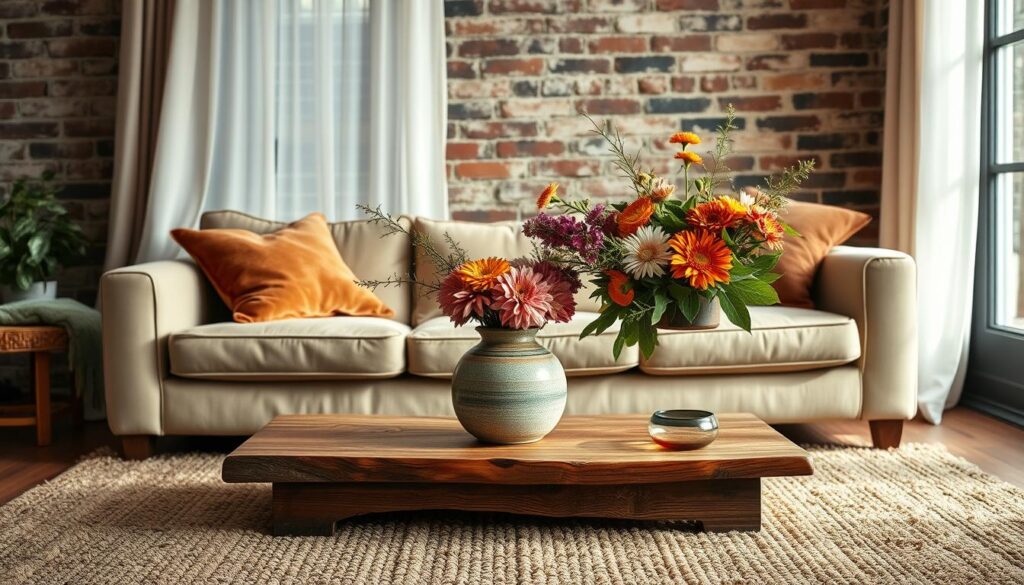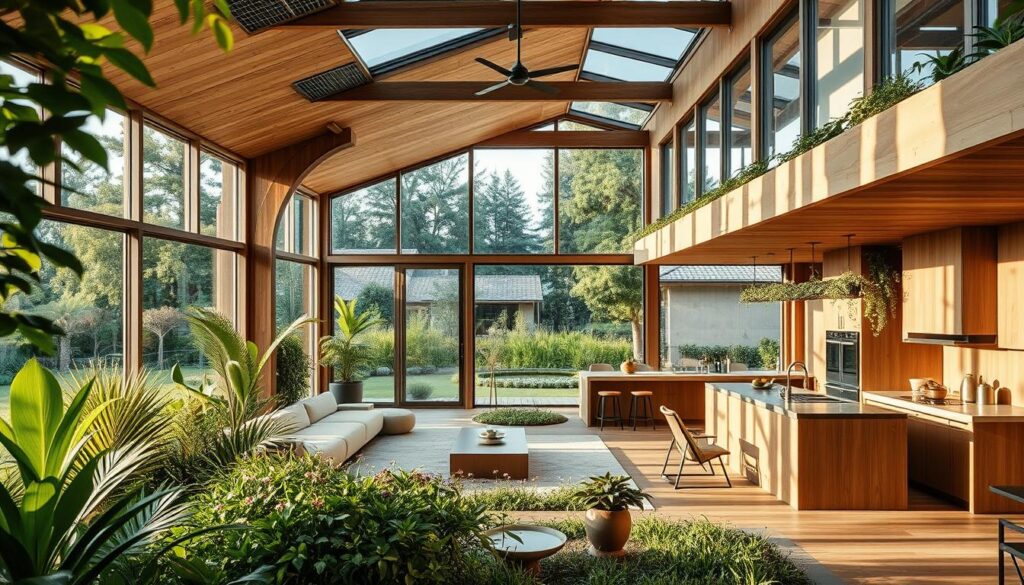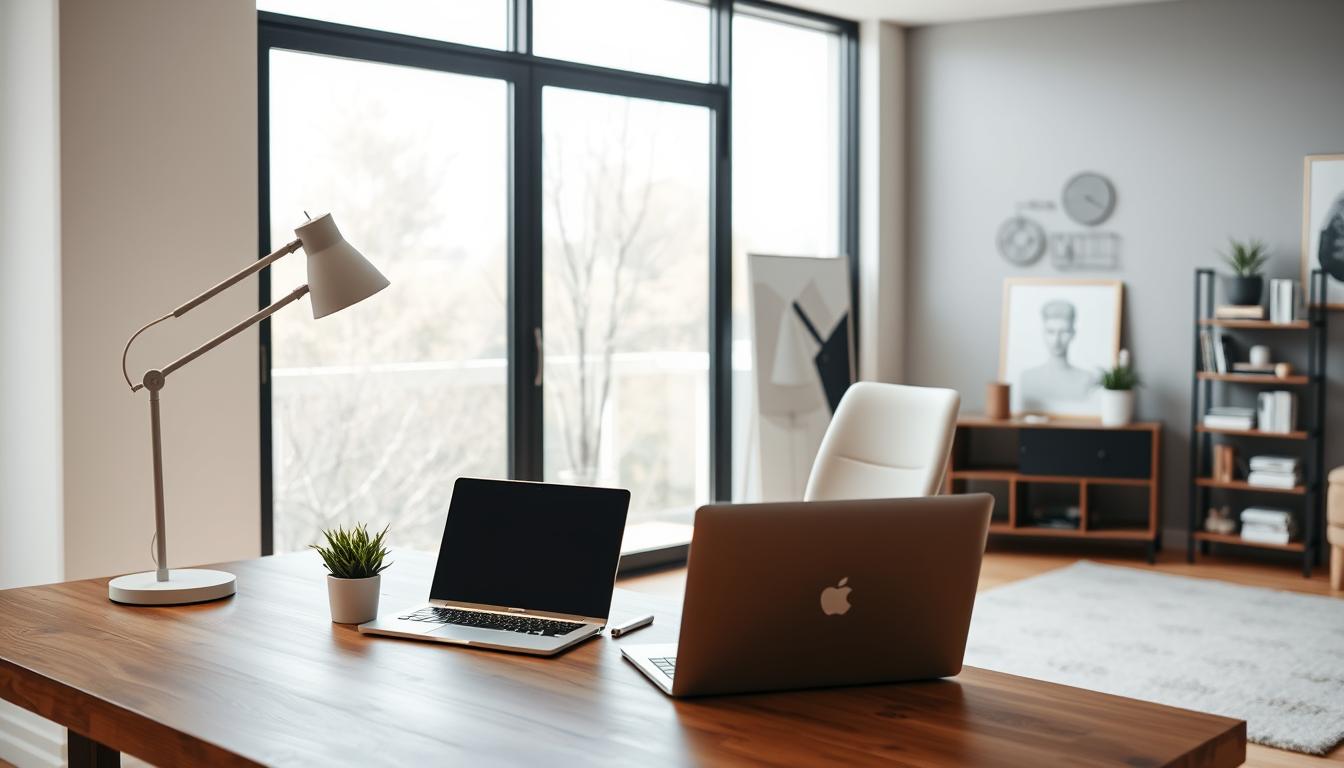Did you know a well-designed space can make you happier and more productive? Creating a stylish interior is more than just following trends. It’s about finding what makes you unique and making smart choices.
Knowing the basics of home design interior is key. It means thinking about colors, furniture, textures, and lighting. This helps create a space that looks good and works well. Enjoy the process of making your space your own, and you’ll get a truly unique and stylish interior design.
Key Takeaways
- Discover your personal style to create a unique space.
- Consider various elements like color, furniture, and lighting.
- Trust the design process to achieve a stylish outcome.
- Explore different interior design ideas to inspire your space.
- Make informed decisions to create a harmonious and functional space.
Understanding the Basics of Home Design Interior
A well-designed home is more than looks; it’s about function too. Home design interior is about making a space beautiful and useful.
Key Elements of Successful Interior Design
Good interior design has a few key parts. Color psychology, furniture selection, and texture integration are crucial. Colors like blue and green calm a room, while red and orange energize it.
Choosing furniture is not just about looks. It’s about picking pieces that are comfy and useful. Adding different textures makes a room feel welcoming.
Importance of Space Planning
Space planning is vital in home design interior. It’s about arranging furniture to use space well and ensure a smooth flow. Good planning can make a room feel bigger or cozier.
It helps find the best layout for the room’s purpose. Whether it’s for relaxing, entertaining, or working, space planning is key.
By understanding and using these basics, we can make a home that looks good and feels great. Whether it’s a single room or a whole house, these principles help create a space that suits your needs and style.
Choosing the Right Color Palette for Your Home
A well-chosen color palette is key to a harmonious home. The colors you pick can make your home feel spacious, cozy, or lively.
Color Psychology in Interior Design
Colors deeply affect our emotions and views. For example, blues and greens bring calmness and serenity, perfect for bedrooms and bathrooms. Reds and oranges, on the other hand, boost energy and excitement, fitting well in living areas and kitchens.
Knowing how colors influence us helps in picking the right palette. Also, think about the natural light in your rooms. It changes how colors look at different times.
Tips for Mixing and Matching Colors
Mixing colors can be tricky, but with some tips, it gets easier. The 60-30-10 rule is helpful: 60% of a main color, 30% of a secondary color, and 10% of an accent color. This mix creates a balanced and attractive palette.
| Color Category | Percentage | Example Colors |
|---|---|---|
| Dominant Color | 60% | Soft Gray, Cream |
| Secondary Color | 30% | Warm Beige, Light Blue |
| Accent Color | 10% | Deep Red, Rich Gold |
Use this rule to plan your walls, furniture, and decor. For a modern look, a bold accent color can stand out against a neutral background.
By carefully choosing your colors and understanding color psychology, you can make a home that’s both stunning and personal.
Selecting Furniture that Fits Your Style
Furniture selection is key in contemporary design. It affects both looks and function. When picking furniture, think about how each piece will fit together. This creates a cohesive and stylish home.
Considerations for Size and Scale
Choosing furniture that fits the room is crucial. A big sectional sofa can overwhelm a small room. On the other hand, a tiny coffee table might get lost in a big space. Measure your room well and think about each piece’s size.
Think about room traffic too. Make sure there’s enough space between furniture for easy movement. A good rule is to leave at least 30 inches between pieces. This makes the room more functional and welcoming.
Material Choices for Durability and Aesthetics
The materials of your furniture matter a lot. Sustainable materials are popular for being eco-friendly and unique. For example, furniture made from reclaimed wood adds warmth and tells a story.
For durability, look at the construction and materials. Solid hardwoods last longer than engineered woods. Also, the fabric used can affect how long a piece lasts. Stain-resistant treatments and durable fabrics like microfiber help furniture last longer.
In conclusion, picking furniture that fits your style means considering size, scale, and materials. By balancing these, you can make a stylish home that’s both beautiful and functional.
Integrating Textures for Added Depth
Mixing different textures is a key interior decorating tip. It makes a space layered and engaging. Adding various textures brings depth and interest, making the area more welcoming and lively.
Textures are crucial in home renovation. They change a room’s feel. Wood adds warmth, metal is sleek, fabric is soft, and glass is elegant. Each texture awakens our senses and enriches the space.

Popular Types of Textures
Many textures can be used in home design. Some favorites include:
- Wood: Adds warmth and a natural feel.
- Metal: Provides a sleek, modern look.
- Fabric: Softens the space and adds comfort.
- Glass: Creates a sense of openness and elegance.
Mixing Textures Effectively
To mix textures well, find a balance for harmony. Pairing smooth with rough textures is interesting. Here are tips for mixing textures:
- Start with a main texture and add others to complement it.
- Mix textures to create interest without being too much.
- Think about the room’s purpose and feel when choosing textures.
By carefully mixing textures, we can make our homes more stunning and useful.
Lighting: The Unsung Hero of Interior Design
Lighting is a key element in modern home decor. It can change a room’s look and feel. It’s crucial for setting the mood in a space.
Different rooms need different lighting. For example, kitchens and home offices need task lighting for specific tasks. Bedrooms and living rooms benefit from ambient lighting for a cozy feel.
Types of Lighting for Different Rooms
Knowing how each room is used helps choose the right lighting. Here are some common types:
- Task Lighting: Focuses on areas for tasks, like reading lamps or kitchen under-cabinet lights.
- Ambient Lighting: Gives a room a welcoming glow. Examples include ceiling lights and floor lamps.
- Accent Lighting: Highlights special features or areas, like artwork or architectural details, with spotlights or picture lights.
Using different light sources together can make a room more functional and beautiful.
Tips for Layering Light
Layering light means mixing different sources for a great look and function. Here are some tips:
- Begin with a main light source, like a ceiling fixture.
- Add task lights where needed, such as desk lamps or kitchen under-cabinet lights.
- Use accent lights to focus on certain features or areas.
- Think about using dimmers to change light levels for different times or activities.
Experts say, “Layering light is about finding a balance between different sources for a welcoming space.”
“The right lighting can make a room feel cozy, spacious, or even dramatic. It’s all about layering different types of light to achieve the desired effect.”
| Room Type | Primary Lighting Need | Recommended Lighting Types |
|---|---|---|
| Kitchen | Task Lighting | Under-cabinet lighting, pendant lights |
| Bedroom | Ambient Lighting | Ceiling fixtures, table lamps |
| Home Office | Task Lighting | Desk lamps, under-cabinet lighting |
By understanding and layering different lighting types, we can make spaces that are both useful and beautiful.
Creating a Functional Layout
A well-planned layout is key to a successful interior design. It affects both how a space looks and how it works. When designing a home, think about how each space will be used. This helps make the home comfortable and efficient.
The choice between open floor plans and traditional layouts is big in room remodeling. Open floor plans make a space feel bigger and help people interact. Traditional layouts, on the other hand, offer privacy and separate areas for different activities.
Open Floor Plan vs. Traditional Layouts
Choosing between an open floor plan and a traditional layout depends on personal taste and lifestyle. For example, families with young kids might like open layouts for easier watching. People who work from home might choose traditional layouts to keep work and personal life separate.
- Open floor plans encourage community and are great for parties.
- Traditional layouts help create spaces for work and relaxation.
Zoning Spaces for Versatility
Zoning spaces makes a home more versatile. By dividing a big area into zones, you can make spaces that serve different purposes. For instance, a living room can also be a home office or a play area for kids.
To zone spaces well, use furniture, lighting, and colors smartly. These interior design ideas help create a space that is both functional and beautiful. It meets the unique needs of the homeowner.
Incorporating Personal Touches
Adding personal elements to your home design is key for a contemporary design that feels like yours. Unique and meaningful items can make your space look great and tell your story.
Displaying Art and Personal Items
Art and personal items can add character to your home. Show off family heirlooms, travel souvenirs, or artwork that speaks to you. Display them on walls, shelves, or in decorative cases to bring personality to your space.
For more ideas on adding personal touches to your home design, see our guide on how to incorporate personal items effectively.
Customized Decor Ideas
Customized decor can make your home truly unique. Think about monogrammed items or bespoke furniture that shows off your style. These elements add elegance and make your space stand out.
- Personalized wall art with family names or special dates
- Custom-designed furniture that fits your space perfectly
- Monogrammed decor items such as throw pillows or blankets
By carefully adding these personal touches, you can create a stylish home interior that’s both beautiful and meaningful.
Sustainable Home Design Practices
Sustainable home design is now essential, not just a trend. It’s a big step towards a greener future. By adding eco-friendly elements, we make our homes better for the planet.

Eco-Friendly Materials and Their Benefits
Choosing eco-friendly materials is key in sustainable design. These materials are good for the planet and can make our homes look and work better. Eco-friendly materials come from nature or are recycled, cutting down on waste and raw material use.
Using these materials has many benefits:
- They’re better for the environment
- They improve air quality inside
- They last longer and are more durable
- They add a natural beauty to our homes
| Material | Eco-Friendly Features | Application in Home Design |
|---|---|---|
| Bamboo | Fast-growing, renewable, and biodegradable | Flooring, furniture, and decorative elements |
| Recycled Glass | Made from recycled glass, reduces waste | Countertops, decorative accents, and lighting fixtures |
| Cork | Harvested from cork oak trees without harming them, sustainable | Flooring, wall coverings, and insulation |
Tips for a Sustainable Interior
Creating a green interior is more than just picking the right materials. It’s about making a space that’s both beautiful and eco-friendly. Here are some practical tips for a sustainable home:
- Choose energy-saving lights and appliances.
- Use materials that are good for the planet for furniture and decor.
- Think about the life cycle of products and if they can be reused or recycled.
- Plan carefully to reduce waste during construction or renovation.
By following these tips, we help the planet and make homes that are both lovely and useful.
Incorporating Technology in Home Design
The modern home is more than just looks; it’s about adding technology to make life better. Our homes are getting smarter, more efficient, and more comfortable as we dive into the digital world.
Technology is changing home design in big ways. Smart home devices are making our lives easier. They include voice-controlled lights and thermostats that learn what we like.
Smart Home Devices to Enhance Comfort
Smart home devices are changing how we live. Some top picks include:
- Voice-controlled assistants like Amazon Alexa and Google Home
- Smart thermostats that adjust temperature based on our preferences
- Automated lighting systems that can be controlled remotely
- Smart security cameras that provide real-time monitoring
These devices make our lives simpler and help our homes use less energy.
Future-Proofing Your Space with Technology
As tech keeps getting better, we need to think about making our homes ready for the future. This means choosing devices and systems that will still be useful years from now.
Here are some ways to make your home future-proof:
- Installing smart home hubs that can connect with many devices
- Ensuring our home’s setup can handle new tech
- Buying devices that work with different systems
By doing these things, we can make our homes not just stylish but also cutting-edge and ready for new tech.
Looking ahead, tech will keep shaping our home designs. By using smart devices and preparing our homes for the future, we can make spaces that truly fit the 21st century.
Seasonal Decor: Keeping It Fresh
As the seasons change, updating our home decor keeps our space fresh and exciting. This lets us show off the current season’s mood and style. It also gives us a chance to refresh our living area.
Refreshing Your Space with the Seasons
Changing our decor with the seasons is easy. Just update a few key things. Here are some effective tips for seasonal transitions:
- Update textiles like throw pillows, blankets, and rugs to match the season’s colors and textures.
- Add seasonal items like holiday decorations, summer flowers, or autumn foliage for a timely touch.
- Think about the lighting; use warmer tones in winter and cooler tones in summer.
Creating a Timeless Style
Seasonal decor is fun, but keeping a timeless style is also key. We should mix seasonal items with permanent pieces.
Here’s how to create a style that lasts:
- Invest in quality, timeless furniture that won’t go out of style.
- Use a neutral color palette as a base, adding seasonal colors with accessories.
- Add personal items and art that show our personality and style.
This balance lets us enjoy seasonal decor while keeping our home stylish and cohesive.
The Importance of Maintenance in Interior Design
Keeping your home’s interior in top shape is key to its beauty and function over time. Regular care is vital to make sure your design lasts, whether it’s modern or traditional.
Upkeep Strategies
Good maintenance means cleaning often, polishing surfaces, and fixing any damage quickly. This way, you avoid damage and keep your furniture and decor looking great for longer. It’s a smart move to protect your investment in home design.
Following some interior decorating tips can also help. For example, dusting often and using the right cleaners is important. We suggest setting up a regular maintenance schedule to keep your home looking its best.
By focusing on maintenance, you can enjoy a beautiful and useful living space for many years. This improves your life and also boosts your home’s value.


